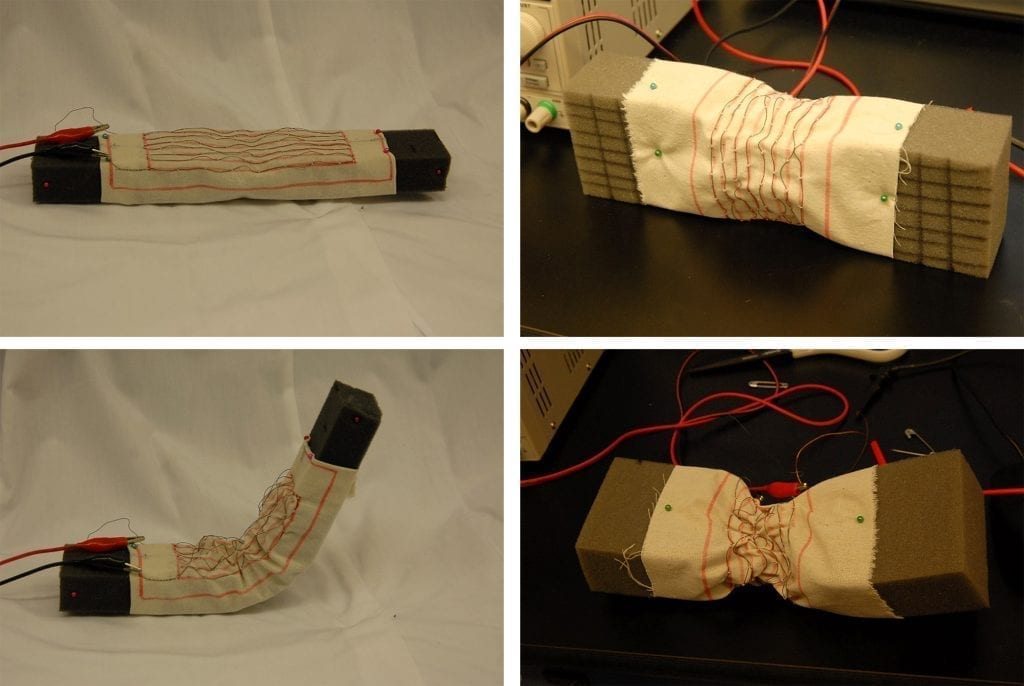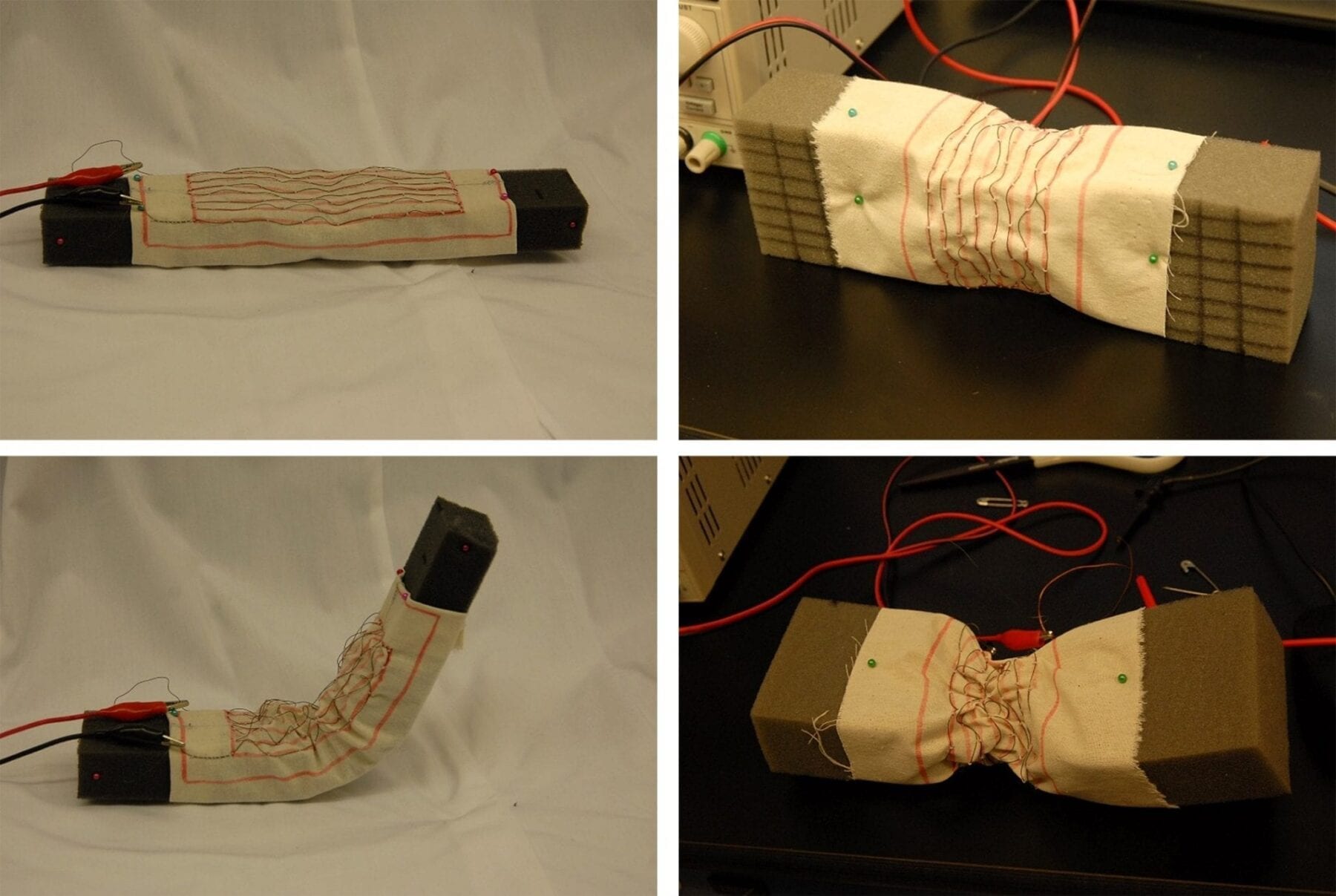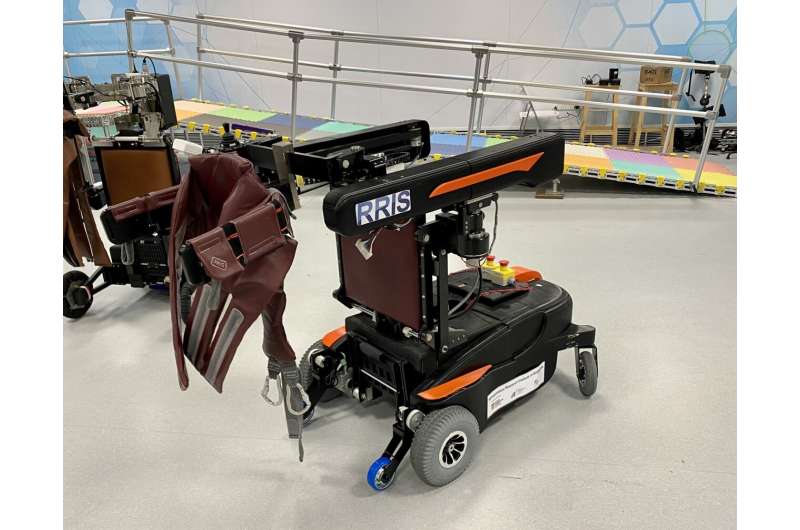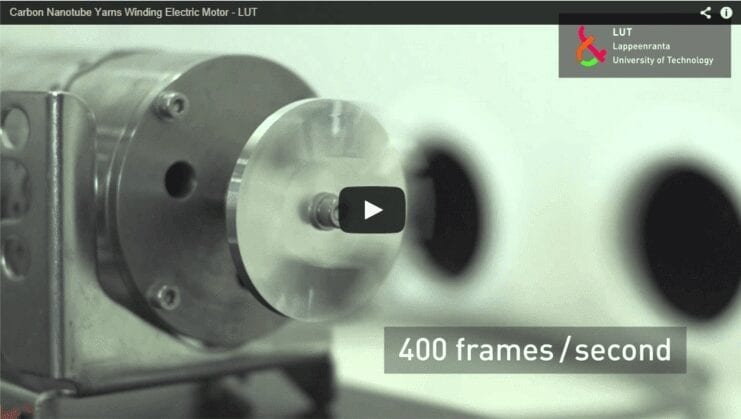
Researchers are developing a robotic fabric that moves and contracts and is embedded with sensors, an approach that could bring “active clothing” and a new class of “soft” robots.
Such an elastic technology could make possible robots that have sensory skin, stretchable robotic garments that people might wear for added strength and endurance, “g-suits” for pilots or astronauts to counteract the effects of acceleration, and lightweight, versatile robots to roam alien landscapes during space missions.
The robotic fabric is a cotton material containing sensors made of a flexible polymer and threadlike strands of a shape-memory alloy that return to a coiled shape when heated, causing the fabric to move.
“We have integrated both actuation and sensing, whereas most robotic fabrics currently in development feature only sensing or other electronic components that utilize conductive thread,” said Rebecca Kramer, an assistant professor of mechanical engineering at Purdue University. “We also use standard sewing techniques to introduce the thread-like actuators and sensors into the fabric, so they could conceivably be integrated into the existing textile manufacturing infrastructure.”
The robotic fabric can be wrapped around a block of foam or an inflated balloon. Orienting the fabric in one direction causes the robot to bend, producing locomotion like an inchworm’s. Orienting the fabric in a different direction causes it to compress – producing a peristaltic – or slithering locomotion.
Findings are detailed in a research paper presented during the International Conference on Intelligent Robots and Systems on Sept. 14–18 in Chicago. The paper was authored by doctoral students Michelle Yuen, Arun Cherian, Jennifer Case and Justin Seipel; and Kramer.
The work is related to research she is leading through a NASA Early Career Faculty award, announced in July, focusing on “active elastic skins for soft robotics.” The skin will contain a shape-memory alloy for muscle-like movement as well as numerous sensors to provide feedback and environmental information.
The goal is to make possible a class of soft robots where all the functional elements are embedded in a stretchable skin. This skin will include flexible electronics that are less sensitive to vibration than conventional hardware, making them rugged enough for space missions. Such a technology could allow space travelers to ship lightweight, easy-to-store sheets of robotic skin for assembly once they reach their destination.
Like the robotic fabric, the skin might be wrapped around a deformable object, creating robots capable of exploring alien terrains.
“We will be able to design robots on the fly,” Kramer said. “Anything can be a robot because all of the robotic technology is in the fabric or skin.”
The Latest on: Robotic fabric
[google_news title=”” keyword=”Robotic fabric” num_posts=”10″ blurb_length=”0″ show_thumb=”left”]
via Google News
The Latest on: Robotic fabric
- Longmont High robotics team wins top award at VEX World championshipon April 29, 2024 at 8:30 pm
The four members of the Longmont High “Pronounce This” robotics team won the top award at the recent high school VEX World championship, giving them the distinction of the best all around team out ...
- Tomorrow's classrooms: Designing schools for the digital ageon April 29, 2024 at 9:34 am
In a world where technology’s rapid pace has reshaped how we live, work, and communicate, it should be no surprise that it’s also changing the PreK-12 education landscape.
- Battle of the best robovacs (that iRobot doesn’t make)on April 28, 2024 at 10:00 am
Dreame’s dual oscillating mop pads also do a better job of getting wet messes off the floor than Roborock’s single flat pad. While Roborock’s mop vibrates up to 4,000 times a minute, Dreame ...
- The Best Vacuums to Keep Your Apartment Clean and Tidy, Testedon April 26, 2024 at 6:55 am
The best vacuums for apartments are compact yet powerful and effective. We tested 8 top options and got expert tips on features to look for. See our results.
- Underwater robot pioneers new energy-efficient buoyancy controlon April 25, 2024 at 11:16 am
A remotely operated underwater robot built by a team of Rice University engineering students pioneers a new way to control buoyancy via water-splitting fuel cells. The device, designed and constructed ...
- From Virtual Fittings to Smart Fabrics: 7 Tech Innovations Revolutionizing Fashionon April 24, 2024 at 10:21 am
Fashion has always been about pushing boundaries and embracing innovation. In today’s digital age, technology is taking center stage in the fashion industry like never before. From virtual fittings ...
- Xiaomi launches Robot Vacuum S10, handheld steamer and moreon April 22, 2024 at 10:50 pm
The new Xiaomi vacuum cleaner has a maximum suction power of 4000Pa to remove the dry dust on the surface. It supports four adjustable suction modes—Silent, Standard, Strong, and Turbo. It also has A ...
- The best budget robot vacuums under $250 can clean up without cleaning you outon April 22, 2024 at 12:36 pm
If you're ready to do some spring cleaning, but want to eliminate some of the drudge work, consider a robot vacuum, or a vacuum and mop combo. There are plenty of options priced under $250 from ...
- Pudu Robotics rolls out robots for navigating industrial environmentson April 22, 2024 at 10:00 am
Pudu Technology Inc., a developer of service robotics, today announced the launch of its first line of robots designed expressly for industrial applications. Pudu makes commercial robotics ...
- Global Fabric Cutting Machine Market Set to Reach US$ 644.4 Million by 2034: Trends and Opportunitieson April 19, 2024 at 7:54 am
The global fabric-cutting machine market is on a trajectory of unprecedented growth, poised to exceed a valuation of US$ 644.4 million by 2034, up from an estimated US$ 429.5 million in 2024. This ...
via Bing News











